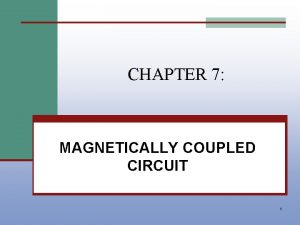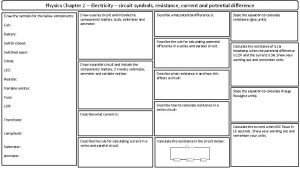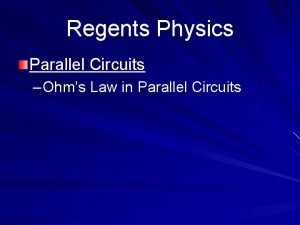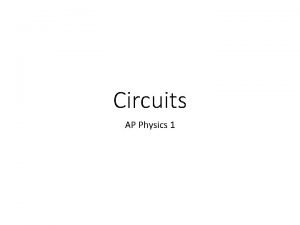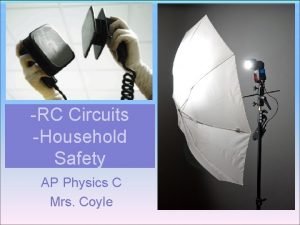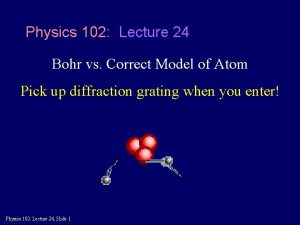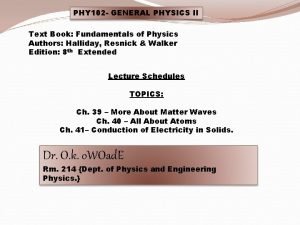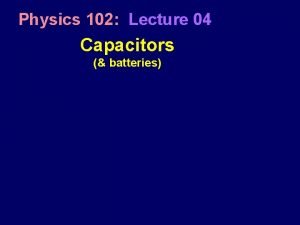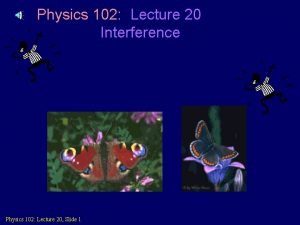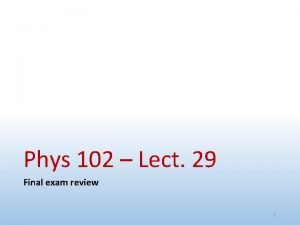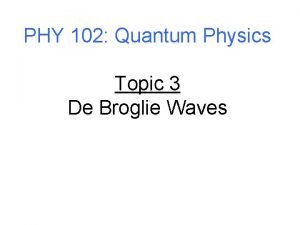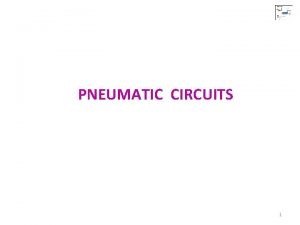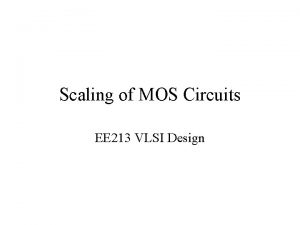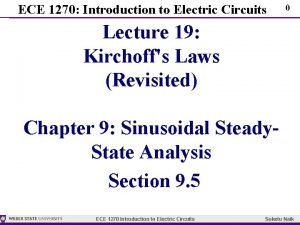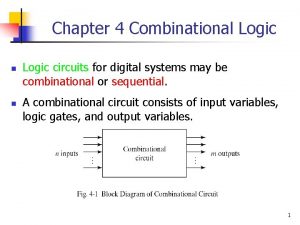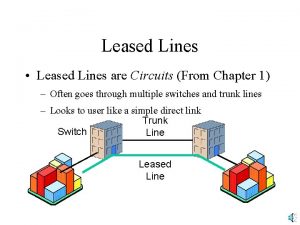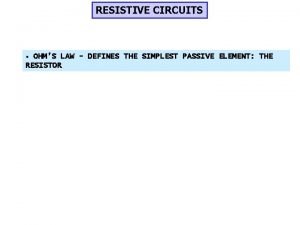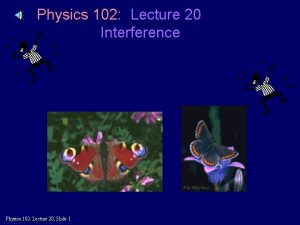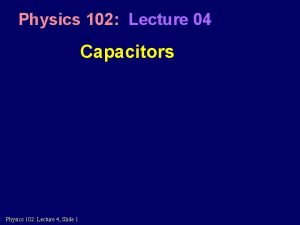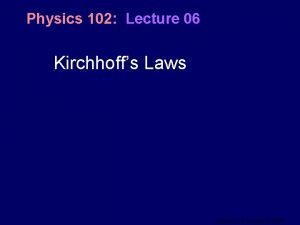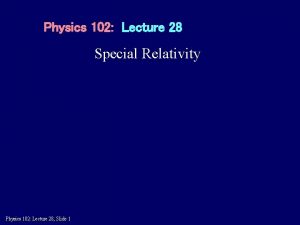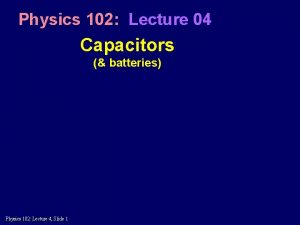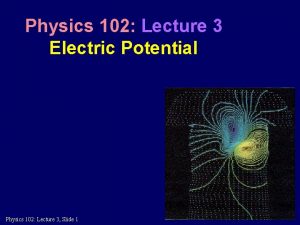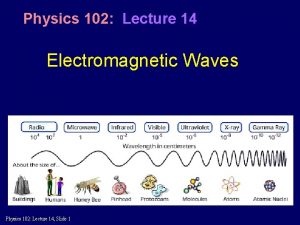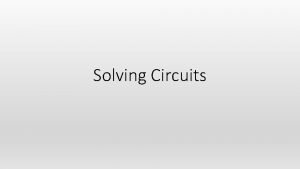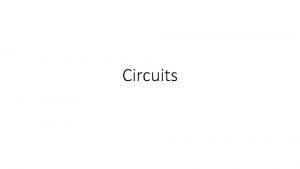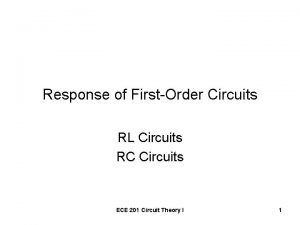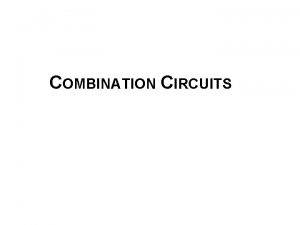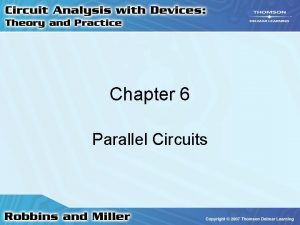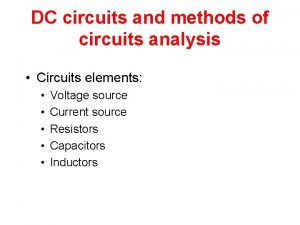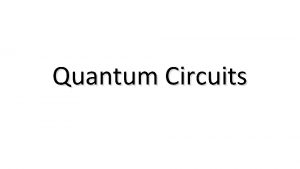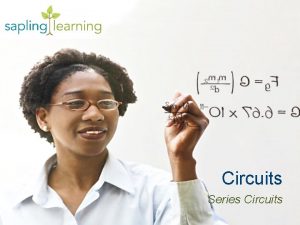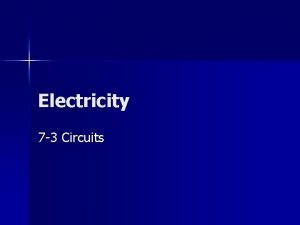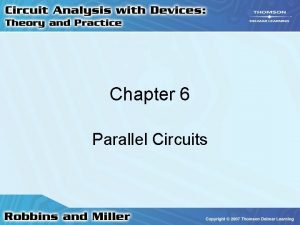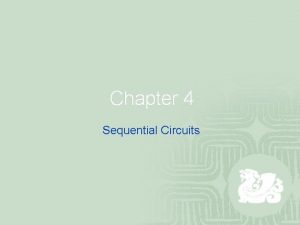Physics 102 Lecture 7 RC Circuits Physics 102































- Slides: 31

Physics 102: Lecture 7 RC Circuits Physics 102: Lecture 7, Slide 1

Recall …. • First we covered circuits with batteries and capacitors – series, parallel • Then we covered circuits with batteries and resistors – series, parallel – Kirchhoff’s Loop and Junction Relations • Today: circuits with batteries, resistors, and capacitors Physics 102: Lecture 7, Slide 2

RC Circuits l Charging Capacitors l Discharging Capacitors l Intermediate Behavior Physics 102: Lecture 7, Slide 3

Physics 102: Lecture 7, Slide 4

RC Circuits l Circuits that have both resistors and capacitors: R 2 S l R 1 C S V With resistance in the circuits, capacitors do not charge and discharge instantaneously – it takes time (even if only fractions of a second). Physics 102: Lecture 7, Slide 5

Capacitors l Charge (and therefore voltage) on Capacitors cannot change instantly: remember VC = Q/C l Short term behavior of Capacitor: èIf the capacitor starts with no charge, it has no potential difference across it and acts as a wire èIf the capacitor starts with charge, it has a potential difference across it and acts as a battery. l Long term behavior of Capacitor: Current through a Capacitor eventually goes to zero. èIf the capacitor is charging, when fully charged no current flows and capacitor acts as an open circuit. èIf capacitor is discharging, potential difference goes to zero and no current flows. Physics 102: Lecture 7, Slide 6

Charging Capacitors l Capacitor is initially uncharged and C switch is open. Switch is then closed. What is current I 0 in circuit immediately S thereafter? l What is current I in circuit a long time later? Physics 102: Lecture 7, Slide 7 R

Physics 102: Lecture 7, Slide 8

Charging Capacitors: t=0 l Capacitor is initially uncharged and switch is open. Switch is then closed. What is current I 0 in circuit immediately thereafter? èCapacitor initially uncharged C R S èTherefore VC is initially 0 èTherefore C behaves as a wire (short circuit) R è- + I 0 R = 0 » I 0 = /R Physics 102: Lecture 7, Slide 9

Charging Capacitors: t>0 èI 0 = /R èPositive charge flows » Onto bottom plate (+Q) » Away from top plate (-Q) » As charge builds up, VC rises (VC=Q/C) » Loop: - + VC + I R = 0 I = ( -VC)/R n Therefore I falls as Q rises + C R n èWhen t is very large ( ) » I = 0: no current flow into/out of capacitor for t large » VC = Physics 102: Lecture 7, Slide 10 Demo R

ACT/Preflight 7. 1 Both switches are initially open, and the capacitor is uncharged. What is the current through the battery just after switch S 1 is closed? + 2 R - 1) Ib = 0 6% 2) Ib = E /(3 R) 3) Ib = E /(2 R) 17% 4) Ib = E /R Ib + C - + - R S 2 S 1 Physics 102: Lecture 7, Slide 11

Physics 102: Lecture 7, Slide 12

ACT/Preflight 7. 3 Both switches are initially open, and the capacitor is uncharged. What is the current through the battery after switch 1 has been closed a long time? + 2 R - 1) Ib = 0 5% 2) Ib = E/(3 R) 3) Ib = E/(2 R) 11% 4) Ib = E/R Ib + C - + - R S 2 S 1 Physics 102: Lecture 7, Slide 13

Discharging Capacitors l Capacitor is initially charged (Q) and switch is open. Switch is then closed. What is current I 0 in circuit immediately thereafter? l What is current I in circuit a long time later? R C S Physics 102: Lecture 7, Slide 14

Discharging Capacitors l Capacitor is initially charged (Q) and switch is open. Switch is then closed. What is current I 0 in circuit immediately thereafter? è-Q/C + I 0 R = 0 èI 0 = Q/RC l What later? is current I in circuit a long time èI = 0 Physics 102: Lecture 7, Slide 15 R C + -

Physics 102: Lecture 7, Slide 16

ACT/Preflight 7. 5 After switch 1 has been closed for a long time, it is opened and switch 2 is closed. What is the current through the right resistor just after switch 2 is closed? + 2 R - 1) IR = 0 3) IR = /(2 R) IR 2) IR = /(3 R) 4) IR = /R + - S 1 Physics 102: Lecture 7, Slide 17 + + C - R - S 2

ACT: RC Circuits Both switches are closed. What is the final charge on the capacitor after the switches have been closed a long time? + 2 R - 1) Q = 0 3) Q = C E /2 2) Q = C E /3 4) Q = C E IR + - S 1 Physics 102: Lecture 7, Slide 18 + + C - R - S 2

RC Circuits: Charging The switches are originally open and the capacitor is uncharged. Then switch S 1 is closed. • Loop: - + I(t)R + q(t) / C = 0 • Just after…: q =q 0 – Capacitor is uncharged + R + - I - + - – - + I 0 R = 0 I 0 = / R • Long time after: Ic= 0 S 1 – Capacitor is fully charged – - + q /C =0 q = C • Intermediate (more complex) q(t) = q (1 -e-t/RC) I(t) = I 0 e-t/RC Physics 102: Lecture 7, Slide 19 q RC 2 RC q 0 t C S 2

Physics 102: Lecture 7, Slide 20

RC Circuits: Discharging • Loop: - q(t) / C - I(t) R = 0 + • Just after…: q=q 0 – Capacitor is still fully charged – -q 0 / C - I 0 R = 0 I 0 = -q 0 / (RC) R + - I - C • Long time after: Ic=0 – Capacitor is discharged (like a wire) S 1 – -q / C = 0 q = 0 RC • Intermediate (more complex) q(t) = q 0 e-t/RC Ic(t) = I 0 e-t/RC S 2 2 RC q t Physics 102: Lecture 7, Slide 21 + -

What is the time constant? l The time constant = RC. l Given a capacitor starting with no charge, the time constant is the amount of time an RC circuit takes to charge a capacitor to about 63. 2% of its final value. l The time constant is the amount of time an RC circuit takes to discharge a capacitor by about 63. 2% of its original value. Physics 102: Lecture 7, Slide 22

Time Constant Demo Each circuit has a 1 F capacitor charged to 100 Volts. When the switch is closed: • Which system will be brightest? • Which lights will stay on longest? • Which lights consumes more energy? 1 = 2 RC Physics 102: Lecture 7, Slide 23 2 I=2 V/R 1 Same U=1/2 CV 2 2 = RC/2

Physics 102: Lecture 7, Slide 24

Summary of Concepts • Charge (and therefore voltage) on Capacitors cannot change instantly: remember VC = Q/C • Short term behavior of Capacitor: – If the capacitor starts with no charge, it has no potential difference across it and acts as a wire – If the capacitor starts with charge, it has a potential difference across it and acts as a battery. • Long term behavior of Capacitor: Current through a Capacitor eventually goes to zero. – If the capacitor is charging, when fully charged no current flows and capacitor acts as an open circuit. – If capacitor is discharging, potential difference goes to zero and no current flows. • Intermediate behavior: Charge and current exponentially approach their long-term values = RC Physics 102: Lecture 7, Slide 25

Practice! + Calculate current immediately after switch is closed: - I + - Calculate current after switch has been closed for 0. 5 seconds: R C E S 1 R=10 W C=30 m. F E =20 Volts Calculate current after switch has been closed for a long time: Calculate charge on capacitor after switch has been closed for a long time: Physics 102: Lecture 7, Slide 26 + -

ACT: RC Challenge R=2 W After being closed for a long time, the switch is opened. What is the charge Q on the capacitor 0. 06 seconds after the switch is opened? 1) 0. 368 q 0 2) 0. 632 q 0 3) 0. 135 q 0 4) 0. 865 q 0 Physics 102: Lecture 7, Slide 27 E = 24 Volts C = 15 m. F R C E S 1 2 R

Physics 102: Lecture 7, Slide 28

RC Summary Charging q(t) = q (1 -e-t/RC) V(t) = V (1 -e-t/RC) I(t) = I 0 e-t/RC Discharging q(t) = q 0 e-t/RC V(t) = V 0 e-t/RC I(t) = I 0 e-t/RC Time Constant = RC Large means long time to charge/discharge Short term: Charge doesn’t change (often zero or max) Long term: Current through capacitor is zero. Physics 102: Lecture 7, Slide 29

Charging: Intermediate Times Calculate the charge on the capacitor 3 10 -3 seconds after switch 1 is closed. R = 10 W q(t) = q (1 -e-t/RC) = q V = 50 Volts C = 100 m. F -3 -6) -3 10 /(20 10 )) (1 -e + 2 R - = q (0. 78) Recall q = C Ib + C - = (50)(100 x 10 -6) (0. 78) = 3. 9 x 10 -3 Coulombs Physics 102: Lecture 7, Slide 30 + - R S 2 S 1

Physics 102: Lecture 7, Slide 31
 Advantages of parallel circuit over series circuit
Advantages of parallel circuit over series circuit Magnetically coupled circuits lecture notes
Magnetically coupled circuits lecture notes 01:640:244 lecture notes - lecture 15: plat, idah, farad
01:640:244 lecture notes - lecture 15: plat, idah, farad Physics symbols electricity
Physics symbols electricity Ohm's law worksheet regents physics answer key
Ohm's law worksheet regents physics answer key Ap physics circuit practice problems
Ap physics circuit practice problems Conceptual physics chapter 35 electric circuits
Conceptual physics chapter 35 electric circuits Q=qe^-t/rc
Q=qe^-t/rc Phys 102 uiuc
Phys 102 uiuc Physics 102
Physics 102 Physics 102
Physics 102 Physics 102
Physics 102 Physics 102
Physics 102 Physics 102 final exam
Physics 102 final exam Physics 102
Physics 102 Physics 102
Physics 102 Electric potential lecture
Electric potential lecture Waves pdf notes
Waves pdf notes What is a harmonic wave in physics
What is a harmonic wave in physics Atmospheric physics lecture notes
Atmospheric physics lecture notes Physics 101 lecture 1
Physics 101 lecture 1 Physics 101 lecture notes pdf
Physics 101 lecture notes pdf Classical mechanics
Classical mechanics Simple physics ia ideas
Simple physics ia ideas Modern physics vs classical physics
Modern physics vs classical physics University physics with modern physics fifteenth edition
University physics with modern physics fifteenth edition Pilot control single acting cylinder is also known
Pilot control single acting cylinder is also known Scaling of mos circuits in vlsi
Scaling of mos circuits in vlsi Ece
Ece Chapter 4 combinational logic circuits
Chapter 4 combinational logic circuits Leased circuits
Leased circuits Chegg
Chegg

